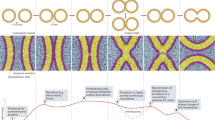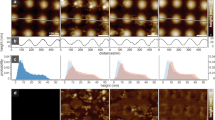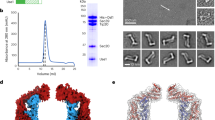Abstract
The core mechanism of intracellular vesicle fusion consists of SNAREpin zippering between vesicular and target membranes. Recent studies indicate that the same SNARE-binding protein, complexin (CPX), can act either as a facilitator or as an inhibitor of membrane fusion, constituting a controversial dilemma. Here we take energetic measurements with the surface force apparatus that reveal that CPX acts sequentially on assembling SNAREpins, first facilitating zippering by nearly doubling the distance at which v- and t-SNAREs can engage and then clamping them into a half-zippered fusion-incompetent state. Specifically, we find that the central helix of CPX allows SNAREs to form this intermediate energetic state at 9–15 nm but not when the bilayers are closer than 9 nm. Stabilizing the activated-clamped state at separations of less than 9 nm requires the accessory helix of CPX, which prevents membrane-proximal assembly of SNAREpins.
This is a preview of subscription content, access via your institution
Access options
Subscribe to this journal
Receive 12 print issues and online access
$189.00 per year
only $15.75 per issue
Buy this article
- Purchase on Springer Link
- Instant access to full article PDF
Prices may be subject to local taxes which are calculated during checkout






Similar content being viewed by others
References
Südhof, T.C. & Rothman, J.E. Membrane fusion: grappling with SNARE and SM proteins. Science 323, 474–477 (2009).
Sørensen, J.B. Conflicting views on the membrane fusion machinery and the fusion pore. Annu. Rev. Cell Dev. Biol. 25, 513–537 (2009).
Hobson, R.J. et al. Complexin maintains vesicles in the primed state in C. elegans. Curr. Biol. 21, 106–113 (2011).
Söllner, T. et al. SNAP receptors implicated in vesicle targeting and fusion. Nature 362, 318–324 (1993).
Weber, T. et al. SNAREpins: minimal machinery for membrane fusion. Cell 92, 759–772 (1998).
Brose, N. For better or for worse: complexins regulate SNARE function and vesicle fusion. Traffic 9, 1403–1413 (2008).
Reim, K. et al. Complexins regulate a late step in Ca2+-dependent neurotransmitter release. Cell 104, 71–81 (2001).
Tang, J. et al. A complexin/synaptotagmin 1 switch controls fast synaptic vesicle exocytosis. Cell 126, 1175–1187 (2006).
Maximov, A. et al. Complexin controls the force transfer from SNARE complexes to membranes in fusion. Science 323, 516–521 (2009).
Schaub, J.R. et al. Hemifusion arrest by complexin is relieved by Ca2+-synaptotagmin I. Nat. Struct. Mol. Biol. 13, 748–750 (2006).
Giraudo, C.G. et al. A clamping mechanism involved in SNARE-dependent exocytosis. Science 313, 676–680 (2006).
Yoon, T.Y. et al. Complexin and Ca2+ stimulate SNARE-mediated membrane fusion. Nat. Struct. Mol. Biol. 15, 707–713 (2008).
Malsam, J. et al. The carboxy-terminal domain of complexin I stimulates liposome fusion. Proc. Natl. Acad. Sci. USA 106, 2001–2006 (2009).
Xue, M. et al. Complexins facilitate neurotransmitter release at excitatory and inhibitory synapses in mammalian central nervous system. Proc. Natl. Acad. Sci. USA 105, 7875–7880 (2008).
Huntwork, S. & Littleton, J.T. A complexin fusion clamp regulates spontaneous neurotransmitter release and synaptic growth. Nat. Neurosci. 10, 1235–1237 (2007).
Xue, M. et al. Tilting the balance between facilitatory and inhibitory functions of mammalian and Drosophila complexins orchestrates synaptic vesicle exocytosis. Neuron 64, 367–380 (2009).
Cho, R.W., Song, Y. & Littleton, J.T. Comparative analysis of Drosophila and mammalian complexins as fusion clamps and facilitators of neurotransmitter release. Mol. Cell. Neurosci. 45, 389–397 (2010).
Xue, M. et al. Distinct domains of complexin I differentially regulate neurotransmitter release. Nat. Struct. Mol. Biol. 14, 949–958 (2007).
Li, F. et al. Energetics and dynamics of SNAREpin folding across lipid bilayers. Nat. Struct. Mol. Biol. 14, 890–896 (2007).
Sutton, R.B. et al. Crystal structure of a SNARE complex involved in synaptic exocytosis at 2.4 A resolution. Nature 395, 347–353 (1998).
Hua, S.Y. & Charlton, M.P. Activity-dependent changes in partial VAMP complexes during neurotransmitter release. Nat. Neurosci. 2, 1078–1083 (1999).
McNew, J.A. et al. Close is not enough: SNARE-dependent membrane fusion requires an active mechanism that transduces force to membrane anchors. J. Cell Biol. 150, 105–117 (2000).
Weninger, K. et al. Accessory proteins stabilize the acceptor complex for synaptobrevin, the 1:1 syntaxin/SNAP-25 complex. Structure 16, 308–320 (2008).
Guan, R., Dai, H. & Rizo, J. Binding of the Munc13–1 MUN domain to membrane-anchored SNARE complexes. Biochemistry 47, 1474–1481 (2008).
Pabst, S. et al. Rapid and selective binding to the synaptic SNARE complex suggests a modulatory role of complexins in neuroexocytosis. J. Biol. Chem. 277, 7838–7848 (2002).
Bracher, A. et al. X-ray structure of a neuronal complexin-SNARE complex from squid. J. Biol. Chem. 277, 26517–26523 (2002).
Chen, X. et al. Three-dimensional structure of the complexin/SNARE complex. Neuron 33, 397–409 (2002).
Giraudo, C.G. et al. Distinct domains of complexins bind SNARE complexes and clamp fusion in vitro. J. Biol. Chem. 283, 21211–21219 (2008).
Giraudo, C.G. et al. Alternative zippering as an on-off switch for SNARE-mediated fusion. Science 323, 512–516 (2009).
Xue, M. et al. Binding of the complexin N terminus to the SNARE complex potentiates synaptic-vesicle fusogenicity. Nat. Struct. Mol. Biol. 17, 568–575 (2010).
Kümmel, D. et al. Complexin cross-links prefusion SNAREs into a zigzag array. Nat. Struct. Mol. Biol. doi:10.1038/nsmb.2101 (2011).
Krishnakumar, S.S. et al. A conformational switch in complexin is required for synaptotagmin to trigger synaptic fusion. Nat. Struct. Mol. Biol. doi:10.1038/nsmb.2103 (2011).
Israelachvili, J.N. & Adams, G.E. Measurement of forces between 2 mica surfaces in aqueous-electrolyte solutions in range 0-100 nm. J. Chem. Soc., Faraday Trans. 74, 975–1001 (1978).
Israelachvili, J. Thin-film studies using multiple-beam interferometry. J. Colloid Interface Sci. 44, 259–272 (1973).
Derjaguin, B.V., Muller, V.M. & Toporov, Y.P. Effect of contact deformations on adhesion of particles. J. Colloid Interface Sci. 53, 314–326 (1975).
Acknowledgements
This work was supported by the Human Frontier Science Program, Agence Nationale de la Recherche (ANR) Physique et Chimie du Vivant (PCV) grant ANR-08-PCVI-0014 to F.P., US National Institutes of Health grants to J.E.R. and a Partner University Funds exchange grant between the Yale and Ecole Normale Supérieure laboratories. D.T. is funded by the ANR Jeunes Chercheuses et Jeunes Chercheurs (JCJC) grant ANR-09-JCJC-0062-01. We thank T. Melia for many helpful discussions, as well as J. Coleman, W. Eng and A. Garcia-Diaz for technical help.
Author information
Authors and Affiliations
Contributions
F.L. and C.G.G. made constructs and did protein purification. F.L. carried out SFA and ITC measurements. C.G.G. did cell-cell fusion assay. F.L., F.P. and D.T. analyzed the data. F.L., F.P., E.P., D.T. and J.E.R. interpreted the results and prepared the manuscript.
Corresponding author
Ethics declarations
Competing interests
The authors declare no competing financial interests.
Supplementary information
Supplementary Text and Figures
Supplementary Figures 1–5, Supplementary Table 1, Supplementary Discussion and Supplementary Methods (PDF 1120 kb)
Rights and permissions
About this article
Cite this article
Li, F., Pincet, F., Perez, E. et al. Complexin activates and clamps SNAREpins by a common mechanism involving an intermediate energetic state. Nat Struct Mol Biol 18, 941–946 (2011). https://doi.org/10.1038/nsmb.2102
Received:
Accepted:
Published:
Issue Date:
DOI: https://doi.org/10.1038/nsmb.2102
This article is cited by
-
Vesicle trafficking and vesicle fusion: mechanisms, biological functions, and their implications for potential disease therapy
Molecular Biomedicine (2022)
-
Focused clamping of a single neuronal SNARE complex by complexin under high mechanical tension
Nature Communications (2018)
-
Membrane curvature sensing by the C-terminal domain of complexin
Nature Communications (2014)
-
The blockade of the neurotransmitter release apparatus by botulinum neurotoxins
Cellular and Molecular Life Sciences (2014)
-
Mechanical unzipping and rezipping of a single SNARE complex reveals hysteresis as a force-generating mechanism
Nature Communications (2013)



